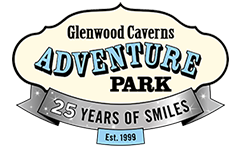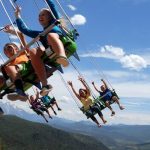
Alpine coasters, including the one at Glenwood Caverns Adventure Park, follow the terrain for scenic rider-controlled downhills.
Alpine coasters have become a popular attraction at ski resorts and amusement parks since they were developed in the mid-1990s as a rail-riding successor to Alpine slides that had been around since the 1970s. Alpine coasters have been built in 12 countries, from Switzerland to New Zealand and Jamaica to Vietnam, as well as 16 states. The longest is Tobotronc in Naturlandia in Andorra—5.3 kilometers with a drop of 400 meters and a ride that can last nearly 10 minutes. The highest is at Glacier 3000, a one-kilometer ride that starts at 2,970-meter elevation and can reach speeds of 25 mph on its two-minute descent.
Unlike traditional roller coasters that build their own hills, Alpine coasters take advantage of the natural terrain’s slope, usually built close to the ground except for bridging. Alpine coasters are the only amusement park ride controlled by the rider. One or two people sit in the car, and a hand brake regulates the speed. The settings often offer breathtaking views—Tobotronc runs through the La Rabassa forest—and some riders prefer to take a more leisurely sightseeing pace.
The one-kilometer Alpine Coaster at Glenwood Caverns Adventure Park, ranked No. 1 by tripping.com, was the first of its kind in the United States. Colorado’s slopes naturally make it a leading site for Alpine coasters, with highly-ranked rides in Vail and Steamboat Springs. In addition to Rocky Mountain states such as Wyoming and Utah and Appalachian Mountain states from Vermont to Georgia, Alpine coasters are found in South Dakota, New Jersey, Minnesota, and Missouri.







